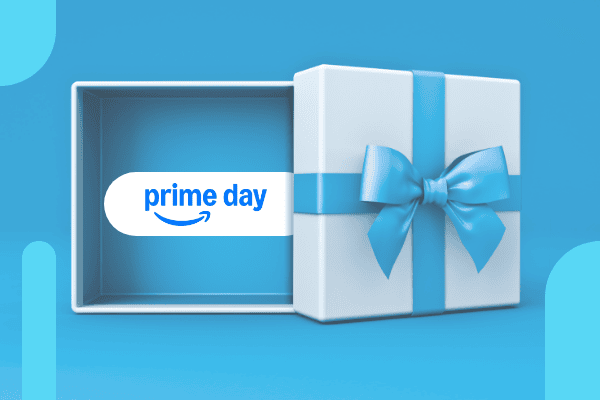Summary
Amazon Prime Day 2025 set new records for media efficiency, with U.S. ecommerce sales hitting $24.1 billion—up 30.3% from 2024. Retail media teams optimized Amazon Ads performance using full-funnel strategies, pacing spend across the event’s four days. The result: record click-through rates and reduced cost-per-click, solidifying Prime Day 2025 as the most efficient Amazon Ads event in history.
Amazon Prime Day 2025 didn’t just stretch the calendar, it reshaped it. Thanks to the four-day event as well as concurrent sales at other major retailers such as Walmart, Target, and others, U.S. ecommerce hit $24.1 billion, a 30.3% increase over 2024, more than doubling what consumers spent during Black Friday last year.
That growth wasn’t limited to big-ticket splurges. Two-thirds of Prime Day items sold for under $20, highlighting how consumers combined everyday essentials with larger purchases. According to Skai’s Summer Deals Consumer Survey, conducted in May among 1,000 U.S. consumers before the event, 85% planned to shop at least one of the summer deal events in 2025. However, economic uncertainty was a key factor, with 62% of consumers planning to cut back spending due to inflation and 44% due to economic uncertainty.
While consumer behavior and sales figures tell one side of the story, the advertising performance data reveals how retail media teams navigated this unprecedented four-day window, and what it means for the future of peak retail moments.
What does the advertising data tell us about Prime Day?
For retail media marketers, the stakes were equally high. Before Prime Day 2025 began, there was speculation about whether a four-day event would result in a proportional [doubled] increase in advertiser investment or if brands would spread their spend more strategically. As we tracked Amazon Ads performance daily through LinkedIn updates, across clients in our platform, the answer became clear: marketers were measured and deliberate, pacing their budgets across all four days.
The 2025 event did end up eclipsing 2024 in ad spend, albeit at a more modest rate of year-over-year growth than we had seen before. Nevertheless, it was the biggest Prime Day in Amazon Ads history: Our preliminary data released on Day 2 showed efficiency taking center stage, with CTR up 30.5% and CPC down 15.5% despite lighter spend volumes. On Day 3, we observed the lowest CPC and highest CTR of any single Prime Day over the last three years. The final Day 4 analysis revealed that advertisers made a strong push to capitalize on the remaining hours, with Amazon DSP emerging as a standout format, growing from 13.6% of the advertising mix on Day 1 to 17.9% on Day 3.
In response to economic uncertainty, advertisers shifted spend toward essential categories. Our Day 4 data showed Food & Grocery advertising increased 50.3% year-over-year, while Health Products climbed 41.6%, a shift that aligned with broader consumer sentiment about economic pressures.
Now that the event is over, we’ve analyzed the complete Amazon Ads performance data from both the event period and the 30 days leading up to it, compared results to previous years, and identified the key shifts that defined how retail media teams approached Prime Day 2025. The findings reveal not just record sales, but a new playbook for advertising efficiency during peak retail moments.
Methodology: This analysis examines performance across all Skai Amazon Advertising accounts globally from the July 2023 and 2024 Prime Days, as well as from June 8 through July 11, 2025. It only includes accounts that spent on Sponsored Ads every day during these events.
Advertisers showed up ready to scale: Prime Day results outpaced pre-event performance
While year-over-year comparisons offer valuable perspective, 2025 wasn’t a typical Prime Day year. Between economic uncertainty, shifting consumer sentiment, and Amazon’s move to a four-day event format, the dynamics felt noticeably different than 2024. Many brands entered the event prepared to deploy their budget strategically throughout Prime Day, rather than front-loading their spend early or tapering off too soon.
To better reflect that reality, we compared the daily averages with those of the 30 days leading up to Prime Day to show the true scale of impact driven during the event window.
Event Period: July 8-11, 2025
Baseline Period: June 8 – July 7, 2025
When measured by the daily average, every major Amazon Ads metric showed significant growth during the event compared to the baseline.:
On average, brands spent nearly 3X more per day during Prime Day 2025 than they did in the weeks before. And they weren’t just increasing spend, they were scaling with intent. With four full days to work with, advertisers showed steady momentum. That’s why both clicks (+108% daily) and impressions (+114% daily) climbed smoothly rather than spiking early.
Conversions followed suit, up 153% per day compared to pre-event levels. That lift reflects how consumers approached the event, too. According to eMarketer, consumers didn’t just buy low-cost items; they also traded up in big-ticket categories, such as electronics (+57% sales growth), while still stocking up on essentials. Two-thirds of items sold on Amazon during Prime Day were under $20, and it’s that balance of high- and low-value purchases that is exactly what showed up in advertiser revenue: daily revenue was almost 3X higher than the weeks leading up. Deep discounts prompted consumers to “trade up” to higher-ticket items, with the share of top-tier products sold jumping 20% compared to year-to-date averages.
Breaking down Prime Day performance by event halves reveals strategic shifts
With Prime Day expanding from two days in 2024 to four days in 2025, total event averages only tell part of the story. For example, a direct comparison between Day 1 in 2024 and 2025 isn’t an accurate measure. To better understand how advertisers adapted to the extended window, we broke performance down into two halves:
- 1st Half (2024 Day 1) vs. (2025 Days 1 & 2)
- 2nd Half (2024 Day 2) vs. (2025 Days 3 & 4)
This split illustrates how pacing and engagement evolved across both the early and later phases of the event.
Notable numbers:
- 2nd half: flat spend, more clicks. Advertiser spend was flat YoY (0.3%) in the second half of Prime Day 2025, but clicks were up nearly 20%. That shows consumers were still interested even as the event wound down, and advertisers continued to capitalize on the influence of the first two days.
- CPC adjustments show intra-event pacing. Marketers were able to reduce CPCs year over year in both halves; however, in Days 3 & 4, 2025, the CPC dropped 16.2% compared to Day 2, 2024. That indicates advertisers adjusted bids to value mid-event pacing budget rather than pushing too hard early or late.
First half 2025 (Days 1 and 2) spend was up 19.6% compared to first half 2024 (Day 1), while clicks rose 26.1%. CTR improved sharply—from 0.24% in 2024 to 0.32% in 2025—while CPC decreased slightly. This combination shows strong early-event momentum: more engagement at a lower cost per click.
The second half followed a different pacing pattern. While spending in 2025 (Days 3 and 4) held nearly flat year over year, clicks still increased by +19.7% led by the dramatic increase in CTR (0.24% in the second half of 2024 (Day 2) to 0.33% in the second half of 2025).
Prime Day 2025 came to a dramatic finish, with brands fine-tuning their promotional strategies in the final hours, while beating 2024 spend, and consumers reportedly showed significant purchasing activity in the closing stretch.
Advertisers balanced record-breaking scale with smarter, more efficient strategies
As retail media matures, so does the approach advertisers take to peak events like Prime Day. Success today isn’t measured just by how much is spent; it’s about how smartly those budgets are deployed.
That mindset was clearly in play during Amazon’s first-ever four-day Prime Day event.
Two numbers highlight the savviness of Prime Day advertisers: the cost-per-click (CPC) fell to $1.80, down 10.4% from 2024’s $2.01—the lowest level recorded in the past three years. Click-through rate (CTR) rose to 0.32%, up 33.3% from 2024’s 0.24%—the highest in the same period.
Rising CTR isn’t just a good metric on a report; it’s a proxy for consumer engagement. Higher CTR means consumers found the ads more relevant, more appealing, and worth acting on. While individual brand strategies differ, the factors that typically drive this kind of efficiency gain are well established: tighter audience targeting and sharper product listings that entice shoppers to click: better titles, competitive prices, higher reviews, and more compelling images.
Marketers weren’t just chasing clicks; they were aligning budgets with what consumers actually responded to. According to Momentum Commerce, 25.6% of products on Amazon US featured discounts this year, up from 23.6% in 2024. At the same time, the average depth of those discounts decreased slightly to 21.7% from 24.4%. That balance points to a deliberate effort to attract attention while maintaining margin discipline—part of why CTR climbed even as CPC fell.
On the CPC side, the 10.4% drop from 2024 reflects a broader shift in bidding behavior. Advertisers didn’t simply bid higher to secure early event visibility. With a full four-day window, pacing became more important to squeeze the most clicks from the budget even while facing the most competitive moment of the year. That discipline likely helped keep CPC in check while still capturing high-intent consumers across the full event window.
It’s also worth noting the structural shifts that likely contributed to this efficiency trend. Amazon’s decision to double the length of Prime Day wasn’t just about consumer convenience. Extending the event provided brands with more ad inventory to work with, thereby spreading out demand and creating more room for marketers to pace their budgets without overbidding.
Amazon DSP advertising spend increases year-over-year as brands embrace full-funnel strategies
One of the clearest format-level shifts Skai observed during Prime Day 2025 was the growing role of Amazon’s Demand-Side Platform (DSP). DSP’s share of total Amazon Ads spend continues to rise year after year—an unmistakable signal that advertisers are evolving toward more full-funnel strategies, blending lower-funnel conversion drivers with upper- and mid-funnel tactics designed to build awareness and consideration.
As Kevin Weiss, Skai’s VP of Commerce Media, noted:
“Amazon DSP isn’t just for the biggest advertisers anymore. Amazon has been actively democratizing DSP access, making it easier for any brand, no matter the size, to fold DSP into their mix. That’s changing the way retail media strategies look across the board.”
That democratization is part of why full-funnel thinking is showing up in platform data. Across Prime Day 2025, smaller and mid-size brands leaned into DSP to reach audiences both onsite and offsite, not just for retargeting, but for building awareness and mid-funnel consideration ahead of key conversion moments.
Where is that DSP growth coming from? The clearest source is Sponsored Display, which saw its share of total spend shrink significantly from 3.3% in 2023 to just 1.3% in 2025. Sponsored Brands also saw a smaller decline, but Sponsored Display was the more notable shift.
Why does Amazon DSP’s share of spend continue to grow year-over-year?
- Onsite + offsite reach. Unlike Sponsored Display, DSP extends targeting offers a greater reach, which mattered more with four full days to fill. Marketers weren’t just chasing conversions, they needed consistent volume across the event. DSP’s onsite + offsite reach helped balance upper-, mid-, and lower-funnel needs, keeping brands visible even as shoppers moved between browsing and buying.
- Finer targeting control unlocked smarter pacing. During a stretched event like Prime Day 2025, advertisers utilized Amazon’s audience data to adjust their strategies in near real-time, holding back or accelerating their spend as signals changed. That level of targeting control gave DSP an edge over fixed Sponsored Display formats.
- Full-funnel became the default, not an add-on. Advertisers weren’t waiting for lower-funnel performance to dip before layering on awareness. Prime Day 2025 demonstrated brands adopting a full-funnel approach from the outset, aligning with the way consumer engagement unfolded throughout the event window.
- A longer event means more ad inventory—and more opportunity to pace. With four days instead of two, managing budgets became about maintaining stability, rather than dealing with spikes. DSP gave advertisers room to stay present across channels without overspending early.
Amazon DSP’s rising share isn’t a one-off spike. It reflects a larger shift in how marketers now approach Prime Day… and retail media as a whole. Full-funnel strategy isn’t just a trend anymore; it’s becoming the standard.
Advertiser spending on essentials reflects broader economic consumer behavior
While Prime Day has historically been seen as an opportunity to push big-ticket items, 2025 revealed a shift in both consumer behavior and advertiser strategy. In a year shaped by economic headwinds, consumers appeared more focused on essentials, and marketers responded accordingly.
The Health and Food & Grocery categories stood out with the largest increases in Amazon Ads spend compared to previous years.
For Prime Day 2025, Food & Grocery ad spend grew more than 2.2X compared to 2023. Health saw nearly 2X growth in the same period. That expansion wasn’t limited to Skai’s platform data, it reflected broader retail trends as well. According to eMarketer, two-thirds of Prime Day 2025 items sold for under $20, with products like protein shakes and cleaning supplies among the top sellers.
Momentum Commerce echoed this in its analysis, noting that while consumers did trade up in some higher-end categories, many focused their spending on must-have items. Advertisers clearly took that signal seriously, investing heavily in categories tied to day-to-day needs rather than treating Prime Day purely as a premium product sales window. We saw early signs of this in our summer survey in May, as 46% of consumers expressed interest in deals on groceries and household essentials, outpacing the year-over-year increase in other popular categories, such as electronics, fashion, and beauty (tied at 22-24%).
Beyond immediate sales, this focus on essentials feeds directly into one of Amazon’s longer-term revenue growth engines: subscriptions. Programs like Subscribe & Save rely on recurring orders for exactly these types of products. While specific Prime Day subscription numbers weren’t published, eMarketer reports that Subscribe & Save adoption continues to grow alongside increased spending in health and grocery categories. Consumers stocking up on everyday items during Prime Day often opt into subscriptions, whether it’s for supplements, pantry staples, or personal care items, helping advertisers turn one-time conversions into long-term, repeat revenue streams.
From a retail media strategy perspective, this shift underscores a broader theme Skai has been following closely: full-funnel thinking isn’t just about layering awareness tactics on top of conversion-focused campaigns. It’s about understanding where consumer priorities are at any given moment, and aligning investment accordingly. In 2025, Prime Day was as much about meeting basic consumer needs as it was about big-ticket shopping. The brands that recognized that mix came out ahead.
Conclusion: Prime Day 2025 proved advertisers can balance growth with measured, efficient strategies
Prime Day 2025 solidified its status as a pivotal retail media event, blending record-breaking sales with evolving consumer and advertiser behaviors. The extended four-day format not only helped boost total U.S. ecommerce to $24.1 billion but also highlighted the value of paced, full-funnel strategies that sustain engagement from essentials to premium buys.
As economic pressures like inflation and tariffs shape consumer caution, brands that prioritize efficiency, personalization, and cross-channel alignment will continue to thrive. Looking forward, the maturation of tools like Amazon DSP and AI assistants signals a future where retail media isn’t just reactive but predictive, turning peak events into year-round growth engines.
Skai’s Retail Media solutions enable marketers to plan, activate, and measure campaigns across 200+ retailers, including Amazon, Walmart, Target, and Instacart, as part of a broader commerce media strategy. AI-powered pacing, product intelligence, and keyword tools help teams meet consumers across the journey and tie spend to sales with confidence.Ready to see how these insights could reshape your approach to peak retail moments? Schedule a quick demo to explore what’s possible for your commerce media program.
Frequently Asked Questions
Prime Day 2025 contributed to record U.S. ecommerce sales while lowering advertising costs. Cost-per-click (CPC) fell 10.4% year-over-year, the lowest in three years, while click-through rate (CTR) increased 33.3%, the highest in the same period. Advertisers achieved stronger engagement at lower costs by pacing spend more strategically across the four-day event.
Rather than front-loading spend into the first two days, brands distributed budgets evenly across all four days. Spend was nearly flat year-over-year in the second half of the event, but clicks still rose 19.7%. This reflects real-time pacing adjustments—marketers optimized bids mid-event, balancing performance and efficiency throughout.
Advertisers leaned into full-funnel strategies, using DSP for onsite and offsite reach, powered by Amazon’s first-party data. This shift away from Sponsored Display and Sponsored Brands points to a broader trend: DSP is becoming a standard tool for retail media marketers of all sizes.







